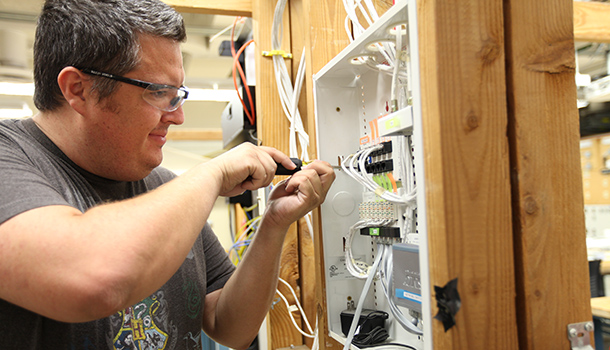
Electrician student at Los Angeles Trade Technical College (Photo Credit: LATTC)
 Sydney Kamlager-Dove is the President of the Los Angeles Community College District Board of Trustees. Ms. Kamlager-Dove has spent more than 20 years working in the nonprofit, entertainment and policy sectors and is a strong voice for the people who live in or near poverty in California.
Sydney Kamlager-Dove is the President of the Los Angeles Community College District Board of Trustees. Ms. Kamlager-Dove has spent more than 20 years working in the nonprofit, entertainment and policy sectors and is a strong voice for the people who live in or near poverty in California.
Last year, I spoke at a conference on youth homelessness. During pubic comment, Paradise stood up and shared her story. She had been in and out of foster care. She was housing insecure. She would sometimes do her homework under the street lamp because she had nowhere to stay. She was a student at LA Trade Tech.
I think about her story often as I navigate the responsibility our community colleges have to Paradise and others.
The people I represent probably don’t know yet that a conversation about economic insecurity has finally started in California—but I guarantee you they will be hopeful when they find out that the California Economic Summit has started this.
Progress, however, matters more than hope. How we develop a sustainable way out of poverty for those 18 million Californians (many of whom are children) who live at or near the poverty level is where the rubber meets the road.
Public education systems are ground zero for the kinds of probative policy debates we need to have around micro inequities and structural discrimination. If California is going to seriously address the yawning gap between rich and poor, then our student population is the target.
I represent the Los Angeles Community College District, which serves more than 230,000 students, 85 percent of which are ethnic minority and more than half live in poverty.
Let me add a few other data points. The LACCD student population is 56 percent female (many of whom are single parents), 46 percent over 25 years of age and 20 percent of them have experienced homelessness during the past school year. These aren’t people who just go to school—they also raise families, hold down multiple jobs, and stretch budgets and time in ways that defy logic.
There is our challenge.
What are the solutions?
There are areas where we must do better in order to restore upward mobility for all of our children.
- We need to be faster. Right now, California community colleges can point to a 47 percent completion rate for an AA or certificate in six years. (LACCD is only 40 percent). Six years is a lifetime for our students. We plan to increase the LACCD rate to 50 percent in the next five years—but all of us, as family members, employers and policymakers, need to demand better and faster results.
- We need to be nimbler, especially in the area of Career Technical Education. It can take a year or more to get a course approved, even when employers tell us that they need the course because of distinct skills that a student may need in order to find a job. It shouldn’t take more than three months. And then there’s the whole portability issue — an approved course at one college may take another year to get approved at another college — and it may not even be the same course!
- We need better tracking. Where do they go? For how long? What sectors are sustainable? Tracking our students in the workforce is problematic. If students are going to enter a community college—they want results. We can’t yet tell them with certainty what they can expect after they graduate.
Through a mutually respectful dialogue, there are many things that must occur at our campuses in order to achieve a better, faster educational experience. And those things often take money. So, what can people outside the community colleges do to help meet these goals? Here are three ideas:
- Encourage legislators to increase investment in community colleges: There are creative ways to incentive attendance, encourage timely completion and create successful warm-handoffs into careers and four-year institutions. Right now, California pays $5,100 for a full-time student. That’s less than half what the State of New York pays.
- Connect local and regional businesses to community colleges: These partnerships will help us develop forward-thinking, transferrable skill-building curriculum. We know that community colleges are career gateways.
- Visit a community college: Challenge your own bias of what a community college is and who attends one. I see them as microcosms of cities. They are diverse ecosystems with folks from all walks of life that feed into our larger communities. They are often overlooked, undervalued, and unleveraged.
It’s going to take much more than just these ideas to improve community college education and the system in which it resides.
But our students, like Paradise, have the same dreams that middle- and upper-class students do, and they deserve the same access, attention and academic rigor. To strive for anything less is to succumb to the soft bigotry of low expectations.
I look forward to the discussion of these and other ideas at the California Economic Summit so that a real policy agenda to address upward mobility in California can occur in the Legislature as early as next year.

